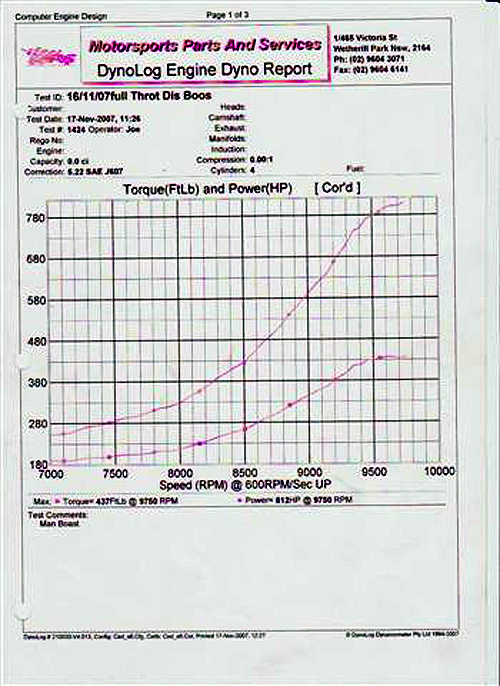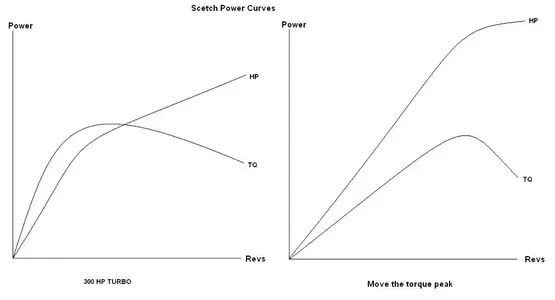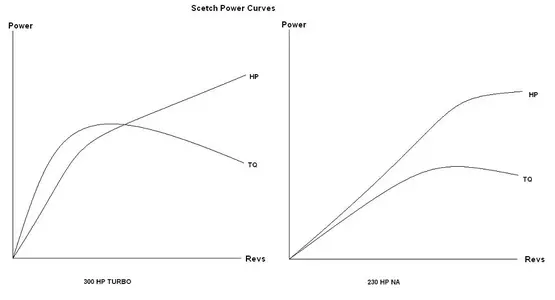Flood1 said:
Hey Griz,
Let's try an example that I have in my driveway, my 2009 BMW 135i. It is 6 cylinder 3.0 litre. It has twin turbos.
Hey Flood,
I should think you have a whole lot of fun in that little car

trouble is its not comparable to a racing / F1 engine.
To cover all bases I need to waffle on for some time, to basically attempt to dismiss what you say and bring you back to my thinking on the power figures, but please bear with me people and take the time to digest what I blurt. I failed English at school so im not the best at making things read easily, sorry, but i have tried to brake down my reasoning in the simplest but most complete way possible...
Those that can be bothered to read this, please give me your thoughts.
Flood1 said:
The normally aspirated version produces 230 HP. My turbo version produces 300 HP. The boost pressure is 8.8 PSI (.6 BAR). The linear math indicates that I got 70 more hp with .6 bar
Why does your engine only make 30% more peak power with 1.6x atmospheric pressure pumped through it?
The NA (Naturally Aspirated) engine and FI (Forced Induction) engine will have very different power curves, BMW are well versed in making a NA 3.0l l6 produce the 300hp you that have in FI format, but they chose not to in this case. Why? Cost and driveability. The old E36 thru E46 M3 l6s ranged from 250hp in the early days right up to 345hp, all be it in 3.2l form at that point. Stunning achievement for a road car, nearly 108hp/litre, but the engines are expensive to build, expensive to maintain and the power is delivered more like a race engine, you have to get up the revs to get the high power.
So why use two turbos to achieve less power?
Your engine is cheaper to build, cheaper to maintain, longer lasting AND gives a better power/torque spread over a much wider range than a similarly powered M3 engine. Road car engines are all about
‘the area under the curve’. The torque curve on your engine will be as smooth and as flat as possible from about 2800rpm giving great driveability and power in any gear just when you need it. This is all made possible with the turbos…
230 + turbos?
Your engine is not a 230hp engine with two turbos. If you
‘switched off’ your turbos your car would make around 190-200hp. Why? There are several factors when comparing to the NA engine:
Both cams will have milder profiles and overlap to aid low end torque and spool time
Both cams will use slightly less lift to aid port velocity at low revs and spool time
The compression ratio will be lowered to help prevent pre-detonation with low octane fuel
The timing will be retarded a few degrees for the same reasons
The air intake system is a lot more restrictive, with a lot more pipe runs, bends, kinks, diameter changes and necks.
The charge air temperature is much higher (less dense, less air, less power)….
Do the same simple sums you did again and your 0.6 Bar is actually be responsible for 100-110hp, which is actually about 1.6x more power with 0.6 Bar boost, which is exactly what we want to find…
190 x 1.6 (your boost)
= 304 (your power)
What BMW have done in doing this though is not just give you 70 more peak HP, they have given you much much more area under the curve, the 230hp NA variant will for arguments sake give 200+hp over a 2500rpm range. Your 300hp engine will give you 280+hp over a 5000rpm range. Do you see how even ignoring the 70hp difference in peak power, you have a lot lot more power overall?
Going back to race engines, screw area under the curve, we don’t need driveability, we can use lots of gears to keep the engine in its peak band of performance so maximum power for available capacity is the goal.
100hp/litre in a NA production engine is a very respectable achievement, very few engines manage it. The M3 engines, M5 v10, the latest Ferrari v8s, the Honda S2000 and one or two others. Go racing and 100hp/L is not going to cut it. 150hp/L is closer to the mark. F1 engines however are currently delivering close to 270hp/L due to the highest VE (Volumetric Efficiency) of any engine in the world. Stunning isn’t it! and it is LINEAR with revs, so half the revs, half the power.
Flood1 said:
so to get 270 more HP (for a total of 500) I would need 2.31 bar.
Give me your calculated 2.31 Bar to play with on your engine and I will make that thing turn 700+hp, not 5.
How? Ill eliminate most of the restrictions and move the torque peak higher, reducing the area under the curve but releasing more power.
Flood1 said:
Is the math actually linear, no It depends on may things. But your math was also linear.
My Maths
My maths are certainly rudimentary, if I used more complex calculations it seems absolutely no one would either read, comment nor understand what im saying, but they are not linear, i assumed a conservative
10% compound reduction in volumetric efficiency with each bar of boost added. The reasons for these losses are down to fluid dynamics and air is a fluid, if anyone would like to propose a different compound reduction factor, please feel free and show me how you derived it.
Top teams could possibly make this number slightly lower, increasing the power figures…
Flood1 said:
By the way, this car red lines at 9000 RPM but is almost twice as big as the proposed 1.6 L.
One or two examples of comparable forced induction F1 engines and one Ford Group A spec:
BMW M12/13 – 1
1500cc L4 – 740 – 800hp @8500rpm @3.0 – 3.2Bar Boost
Zakspeed F1
1500cc L4 – 820hp @ 9500rpm @3.5Bar Boost (no 3.0 Bar numbers available to me)
And possibly my favourite engine in the world!
Ford Zakspeed Capri – 1700cc L4 - 640hp @9000rpm @1.5Bar Boost, that's peak power not red line. (>500hp between 4750 and 9750) 5000rpm of more than 500hp
These are the best 4 cylinder examples I can draw on as living ‘proof’ of my figures obtainable with 1600cc, 3 Bar boost and 10 000+ rpms. The Renault and Honda F1 engines were obviously V configuration with two more cylinders so not quite comparable. Its also worth noting all of these examples were built more than 20 years ago! Without many of the technologies we enjoy today.
So, my question again is, which of the quoted figures of Boost, Capacity and Revs are incorrect?
Maybe there is a clue here:
Flood1 said:
One other thing, according to Dieter Rencken in his autosport article:
According to our source, what has been kicked about for refinement is a set of regulations stipulating relatively crude 1600cc four-cylinder engines using the FIA's Universal Motorsport ('World' – as first disclosed here) Engine as base, but fitted with various advanced technologies such as twin turbos running to 3+ bar boost.
That one word could be the biggest clue yet to my Qs. For an F1 engineer to use the word crude when referring to engines could suggest an (inefficient by comparison) production car type engine.
For examples sake - Linear Maths - 'good' production 1600cc engine - 125hp? -
add 3 Bar with zero losses - 125*4 = 500hp...


 and want to do it alone. I think McLaren have been wanting to develop engines for quite some years now. They designed and built the new engine for the MP4-12c.
and want to do it alone. I think McLaren have been wanting to develop engines for quite some years now. They designed and built the new engine for the MP4-12c.
 trouble is its not comparable to a racing / F1 engine.
trouble is its not comparable to a racing / F1 engine.






